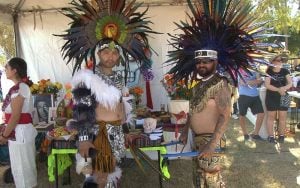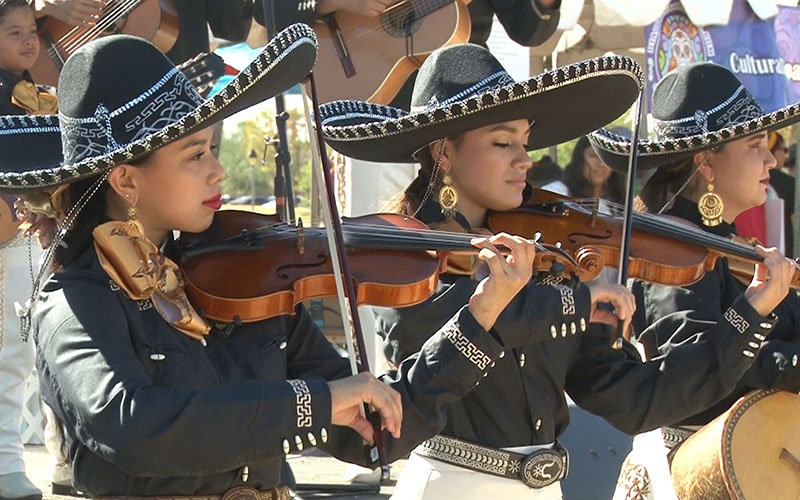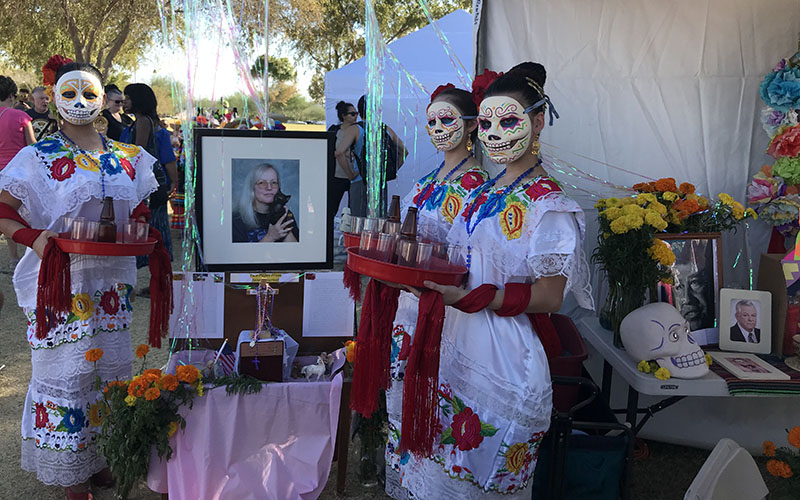PHOENIX — “This connects us to our ancient, indigenous past.”
Día de los Muertos, an annual holiday celebrated in Mexican culture and by those of Mexican descent, has rituals dating back 3,000 years. In anticipation of the multi-day festivities honoring those who have passed on, hundreds gathered over the weekend at Steele Indian School Park to participate in the joyous occasion of celebrating their loved ones and their history.

Two Aztec dancers pose after performing with Danza Coatlicue at the Día de los Muertos Festival in Phoenix. (Photo by Courtney Mally/Cronkite News)
“To me, it’s an excuse to celebrate who we really are as people from Mexico and people with an indigenous past, that this is how we define ourselves,” Zarco Guerrero, president of the board of the Cultural Coalition said. “This is not us being defined by someone else.”
The Day of the Dead starts Oct. 31 and has influences from both indigenous Aztec rituals and the Catholic Church. Due to the long history of this holiday, spanning over multiple regions, the exact rituals and festivities vary from place to place. However, there are certain things that carry over into every celebration, one of them being calacas.
Calacas, or skeletons, are a key symbol in Día de los Muertos celebrations. “Bones are very important to indigenous people,” Guerrero said.
“I think a lot of people think of skeletons and they think fear,” said Patricia Silva, an artist vending at the Día de los Muertos Festival. “My thing is, beauty is within and we’re all skeletons underneath. The most important thing is the beauty of their lives and what they left behind.”
While the holiday is a cultural celebration, those who attended the festival felt that now, in 2017, honoring their past is making a statement about the political climate of the present day.
Laura Fonseca attended with her family in an effort to teach her daughter about the importance of knowing their Hispanic heritage.
“The society in which we live in now, and everything that is going on with social issues in our culture, I just want her to embrace it and see the beauty in it,” Fonseca said.
Guerrero feels as though this celebration is a prime opportunity to share the indigenous culture, while also taking a firm stance on his beliefs.
“Our message is, there are no borders. Our message is, we are not immigrants, we’re migrants. We’ve been migrating for 10,000 years,” Guerrero said. “We don’t accept the fact that people call us immigrants. You cannot be immigrants in your own land, that’s absurd…”
Día de los Muertos festivities will wrap up this year on Nov. 2.

Three violin players performing with Mariachi Juvenil de Mi Tierra at the Día de los Muertos Festival in Phoenix. (Photo by Courtney Mally/ Cronkite News)
